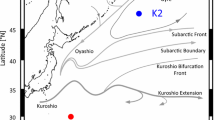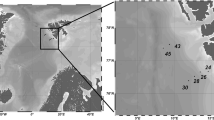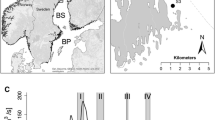Abstract
We investigated seasonal changes in carbon demand and flux by mesozooplankton communities at subtropical (S1) and subarctic sites (K2) in the western North Pacific Ocean to compare the impact of mesozooplankton communities on the carbon budget in surface and mesopelagic layers. Fecal pellet fluxes were one order higher at K2 than at S1, and seemed to be enhanced by copepod and euphausiid egestion under high chlorophyll a concentrations. The decrease in pellet volume and the lack of any substantial change in shape composition during sink suggest a decline in fecal pellet flux due to coprorhexy and coprophagy. While respiratory and excretory carbon by diel migrants at depth (i.e., active carbon flux) was similar between the two sites, the actively transported carbon exceeded sinking fecal pellets at S1. Mesozooplankton carbon demand in surface and mesopelagic layers was higher at K2 than S1, and an excess of demand to primary production and sinking POC flux was found during some seasons at K2. We propose that this demand was met by supplementary carbon sources such as feeding on protozoans and fecal pellets at the surface and carnivory of migrants at mesopelagic depths.









Similar content being viewed by others
References
Abe Y, Natsuike M, Matsuno M, Terui T, Yamaguchi A, Imai I (2013) Variation in assimilation efficiencies of dominant Neocalanus and Eucalanus copepods in the subarctic Pacific: consequences for population structure models. J Exp Mar Biol Ecol 449:321–329
Al-Mutairi H, Landry MR (2001) Active export of carbon and nitrogen at Station ALOHA by diel migrant zooplankton. Deep-Sea Res II 48:2083–2103
Arístegui J, Duarte CM, Agustí S, Doval M, Álvarez-Salgado XA, Hansell DA (2002) Dissolved organic carbon support of respiration in the dark ocean. Science 298:1967
Ayukai T, Hattori H (1992) Production and downward flux of zooplankton fecal pellets in the anticyclonic gyre off Shikoku, Japan. Oceanol Acta 15:163–172
Bedo AW, Acuña JL, Robins D, Harris RP (1993) Grazing in the micron and the sub-micron particle size range: the case of Oikopleura dioica (Appendicularia). Bull Mar Sci 53:2–14
Borgne Le (1982) Zooplankton production in the eastern tropical Atlantic Ocean: net growth efficiency and P: B in terms of carbon, nitrogen, and phosphorous. Limnol Oceanogr 27:681–698
Bradford-Grieve JM, Nodder SD, Jillett KB, Currie K, Lassey KR (2001) Potential contribution that the copepod Neocalanus tonsus makes to downward carbon flux in the Southern Ocean. J Plankton Res 23:963–975
Buesseler KO, Boyd PW (2009) Shedding light on processes that control particle export and flux attenuation in the twilight zone of the open ocean. Limnol Oceanogr 54:1210–1232
Buesseler KO, Lamborg CH, Boyd PW, Lam PJ, Trull TW, Bidigare RR, Bishop JKB, Casciotti KL, DeHairs F, Karl DM, Siegel D, Silver MW, Steinberg DK, Valdez J, Van Mooy B, Wilson SE (2007) Revisiting carbon flux through the ocean’s twilight zone. Science 316:567–570
Chisholm SW (2000) Oceanography: stirring times in the Southern Ocean. Nature 407:685–687
Conover RJ (1988) Comparative life histories in the genera Calanus and Neocalanus in high latitudes of the northern hemisphere. Hydrobiol 167(168):127–142
Dagg MJ (1993) Sinking particles as a possible source of nutrition for the large calanoid copepod Neocalanus cristatus in the subarctic Pacific Ocean. Deep-Sea Res I 40:1431–1445
Deibel D, Lee SH (1992) Retention efficiency of sub-micrometer particles by the pharyngeal filter of the pelagic tunicate Oikopleuira vanhoeffeni. Mar Ecol Prog Ser 81:25–30
Doi H, Kobari T, Fukumori K, Nishibe Y, Nakano S-I (2010) Trophic niche breadth variability differs among three Neocalanus species in the subarctic Pacific Ocean. J Plankton Res 32:1733–1737
Fowler SW, Knauer GA (1986) Role of large particles in the transport of elements and organic compounds through the oceanic water column. Prog Oceanogr 16:147–194
Fowler SW, Small LF, LaRosa J (1991) Seasonal particulate carbon flux in the coastal northwestern Mediterranean Sea, and the role of zooplankton fecal matter. Oceanol Acta 14:77–85
Frost BW, Landry MR, Hassett RP (1983) Feeding behavior of large calanoid copepods Neocalanus cristatus and N. plumchrus from the subarctic Pacific Ocean. Deep-Sea Res 30:1–13
Fujiki T, Matsumoto K, Mino Y, Sasaoka K, Wakita M, Kawakami H, Honda MC, Watanabe S, Saino T (2014) The seasonal cycle of phytoplankton community structure and photo-physiological state in the western subarctic gyre of the North Pacific. Limnol Oceanogr 59:887–900
Giering SLC, Sanders R, Lampitt RS, Anderson TR, Tamburini C, Boutrif M, Zubkov MV, Marsay CM, Henson SA, Saw K, Cook K, Mayor DJ (2014) Reconciliation of the carbon budget in the ocean’s twilight zone. Nature 507:480–483
Gifford DJ (1993) Protozoa in the diets of Neocalanus spp. in the oceanic subarctic Pacific Ocean. Prog Oceanogr 32:223–237
Gleiber MR, Steinberg DK, Ducklow HW (2012) Time series of vertical flux of zooplankton fecal pellets on the continental shelf of the western Antarctic Peninsula. Mar Ecol Prog Ser 471:23–36
Gnaiger E (1983) Calculation of energetic and biochemical equivalents of respiratory oxygen consumption. In: Gnaiger E, Forstner H (eds) Polarogranic oxygen sensors. Springer, Berlin, pp 337–345
González HE, Smetacek V (1994) The possible role of the cyclopoid copepod Oithona in retarding vertical flux of zooplankton fecal material. Mar Ecol Prog Ser 113:233–246
Gowing MM, Garrison DL, Kunze HB, Winchell CJ (2001) Biological components of Ross Sea short-term particle fluxes in the austral summer of 1995–1996. Deep-Sea Res I 48:2645–2671
Greene CH, Landry MR (1988) Carnivorous suspension feeding by the subarctic calanold copepod Neocalanus cnstatus. Can J Fish Aquat Sci 45:1069–1074
Honda MC, Kawakami H, Matsumoto K, Fujiki T, Mino Y, Sukigara C, Kobari T, Uchimiya M, Kaneko R, Saino T (2015) Comparison of sinking particle upper 200 m between subarctic station K2 and subtropical station S1 based on drifting sediment trap experiment. J Oceanogr. doi:10.1007/s2-015-0289-x
Ikeda T (1985) Metabolic rates of epipelagic marine zooplankton as a function of body mass and temperature. Mar Biol 85:1–11
Ikeda T, Sano F, Yamaguchi A (2007) Respiration in marine pelagic copepods: a global-bathymetric model. Mar Ecol Prog Ser 339:215–219
Ikeda T, Shiga N, Yamaguchi A (2008) Structure, biomass distribution and trophodynamics of the Pelagic ecosystem in the Oyashio Region, Western Subarctic Pacific. J Oceanogr 64:339–354
Iversen MH, Poulsen LK (2007) Coprorhexy, coprophagy, and coprochaly in the copepods Calanus helgolandicus, Pseudocalanus elongates, and Oithona similis. Mar Ecol Prog Ser 350:79–89
Iversen MH, Nowald N, Ploug H, Jackson GA, Fischer G (2010) High resolution profiles of vertical particulate organic matter export off Cape Blanc, Mauritania: degradation processes and ballasting effects. Deep-Sea Res I 57:771–784
Kitamura M, Kobari T, Honda MC, Matsumoto K, Sasaoka K, Nakamura R, Tanabe K (2016) Seasonal changes in the mesozooplankton biomass and community structure in subarctic and subtropical time-series stations in the western North Pacific. J Oceanogr. doi:10.1007/s10872-015-0347-8
Knauer GA, Martin JH, Bruland KW (1979) Fluxes of particulate carbon, nitrogen, and phosphorus in the upper water column of the northeast Pacific. Deep-Sea Res A 26:97–108
Kobari T, Ikeda T (1999) Vertical distribution, population structure and life cycle of Neocalanus cristatus (Crustacea: Copepoda) in the Oyashio region, with notes on its regional variations. Mar Biol 134:683–696
Kobari T, Ikeda T (2001a) Life cycle of Neocalanus flemingeri (Crustacea: Copepoda) in the Oyashio region, western subarctic Pacific, with notes on its regional variations. Mar Ecol Prog Ser 209:243–255
Kobari T, Ikeda T (2001b) Ontogenetic vertical migration and life cycle of Neocalanus plumchrus (Crustacea: Copepoda) in the Oyashio region, with notes on regional variations in body size. J Plankton Res 23:287–302
Kobari T, Shinada A, Tsuda A (2003) Functional roles of interzonal migrating mesozooplankton in the western subarctic Pacific. Prog Oceanogr 57:279–298
Kobari T, Moku M, Takahashi K (2008a) Seasonal appearance of expatriated boreal copepods in the Oyashio-Kuroshio mixed region. ICES J Mar Sci 65:469–476
Kobari T, Steinberg DK, Ueda A, Tsuda A, Silver MW, Kitamura M (2008b) Impacts of ontogenetically migrating copepods on downward carbon flux in the western subarctic Pacific Ocean. Deep-Sea Res II 55:1648–1660
Kobari T, Akamatsu H, Minowa M, Ichikawa T, Iseki K, Fukuda R, Higashi M (2010) Effects of the copepod community structure on fecal pellet flux in Kagoshima Bay, a deep, semi-enclosed embayment. J Oceanogr 66:673–684
Kobari T, Kitamura M, Minowa M, Isami H, Akamatsu H, Kawakami H, Matsumoto K, Wakita M, Honda MC (2013) Impacts of the wintertime mesozooplankton community to downward carbon flux in the subarctic and subtropical Pacific Oceans. Deep-Sea Res I 81:78–88
Lampitt RS, Noji TT, von Bodungen B (1990) What happens to zooplankton faecal pellets? Implications for material flux. Mar Biol 104:15–23
Lane PVZ, Smith SL, Urban JL, Biscayn PE (1994) Carbon flux and recycling associated with zooplanktonic fecal pellets on the shelf of the Middle Atlantic Bight. Deep-Sea Res II 41:437–457
Liu H, Dagg MJ, Strom S (2005) Grazing by the calanoid copepod Neocalanus cristatus on the microbial food web in the coastal Gulf of Alaska. J Plankton Res 27:647–662
Longhurst AR, Bedo AW, Harrison WG, Head EJH, Sameoto DD (1990) Vertical flux of respiratory carbon by oceanic diel migrant biota. Deep-Sea Res. 37(4):685–694
Longhurst A, Williams R (1992) Carbon flux by seasonal vertical migrant copepods is small number. J Plankton Res 14:1495–1509
Mackas DL, Tsuda A (1998) Mesozooplankton in the eastern and western subarctic Pacific: community structure, seasonal life histories, and interannual variability. Prog Oceanogr 43:335–363
Maita Y, Odate T, Yanada M (1988) Vertical transport of organic carbon by sinking particles and the role of zoo- and phytogenic matters in neritic waters. Bull Fac Fish Hokkaido Univ 39:265–274
Martens P (1978) Faecal pellets. FichIdent Zooplancton 162:1–4
Martin JH, Knauer GA, Karl DM, Broenkow WW (1987) VERTEX: carbon cycling in the northeast Pacific. Deep-Sea Res 34:267–285
Matsumoto K, Honda CM, Sasaoka K, Wakita M, Kawakami H, Watanabe S (2014) Seasonal variability of primary production and phytoplankton biomass in the western Pacific subarctic gyre: control by light availability within the mixed layer. J Geophys Res 119:6523–6534
Mauchline J (1998) The biology of calanoid copepods. Adv Mar Biol 33:1–710
McDonnel AMP, Buesseler KO (2010) Variability in the average sinking velocity of marine particles. Limnol Oceanogr 55:2085–2096
McGowan JA, Walker PW (1979) Structure in the copepod community of the North Pacific central gyre. Ecol Monogr 49:195–226
McGowan JA, Walker PW (1985) Dominance and diversity maintenance in an oceanic ecosystem. Ecol Monogr 55:103–118
Miller CB, Clemons MJ (1988) Revised life history analysis for large grazing copepods in the subarctic Pacific Ocean. Prog Oceanogr 20:293–313
Miller CB, Frost BW, Batchelder HP, Clemons MJ, Conway RE (1984) Life histories of large, grazing copepods in a subarctic ocean gyre: Neocalanus plumchrus, Neocalanus cristatus, and Eucalanus bungii in the northeast Pacific. Prog Oceanogr 13:201–243
Noji TT, Estep KW, MacIntyre F, Norrbin F (1991) Image analysis of faecal material grazed upon by three species of copepods: evidence for coprohexy, coprophagy, and coprochaly. J Mar Biol Ass United Kingdom 71:465–480
Pace ML, Knauer GA, Karl DM, Martin JH (1987) Primary production, new production and vertical flux in the eastern Pacific Ocean. Nature 325:803–804
Padmavati G, Ikeda T, Yamaguchi A (2004) Life cycle, population structure and vertical distribution of Metridia spp. (Calanoida: Copepoda) in the Oyashio region (NW Pacific Ocean). Mar Ecol Prog Ser 270:181–198
Paffenhöfer G-A, Knowles SA (1979) Ecological implications of fecal pellet size, production and consumption by copepods. J Mar Res 37:35–49
Paffenhöfer G-A, Strickland JDH (1970) A note on the feeding of Calanus helgolandicus on detritus. Mar Biol 5:97–99
Parsons TR, Lalli CM (1988) Comparative oceanic ecology of the plankton communities of the subarctic Atlantic and Pacific Oceans. Oceanogr Mar Biol Ann Rev 26:317–359
Poulsen LK, Iversen MH (2008) Degradation of copepod fecal pellets: key role of protozooplankton. Mar Ecol Prog Ser 367:1–13
Poulsen LK, Kiørboe T (2006) Vertical flux and degradation rates of copepod fecal pellets in a zooplankton community dominated by small copepods. Mar Ecol Prog Ser 323:195–204
Roy S, Silverberg N, Romero N, Deibel D, Kleine B, Savenkofff C, Vézinaf A, Tremblaye J-É, Legendree L, Rivkind RB (2000) Importance of mesozooplankton feeding for the downward flux of biogenic carbon in the Gulf of St. Lawrence (Canada). Deep-Sea Res II 47:519–544
Sherr EB, Barry F, Sherr BF (2002) Significance of predation by protists in aquatic microbial food webs. Ant Leeuwen 81:293–308
Shimode S, Hiroe Y, Hidaka K, Takahashi K, Tsuda A (2009) Life history and ontogenetic vertical migration of Neocalanus gracilis in the western North Pacific Ocean. Aquat Biol 7:295–306
Shimode S, Takahashi K, Shimizu Y, Nonomura T, Tsuda A (2012a) Distribution and life history of the planktonic copepod, Eucalanus californicus, in the northwestern Pacific: mechanisms for population maintenance within a high primary production area. Prog Oceanogr 86:1–13
Shimode S, Takahashi K, Shimizu Y, Nonomura T, Tsuda A (2012b) Distribution and life history of two planktonic copepods, Rhincalanus nasutus and Rhincalanus rostrifrons, in the northwestern Pacific Ocean. Deep-Sea Res I 65:133–145
Shoden S, Ikeda T, Yamaguchi A (2005) Vertical distribution, population structure and lifecycle of Eucalanus bungii (Copepoda: Calanoida) in the Oyashio region, with notes on its regional variations. Mar Biol 146:497–511
Steinberg DK, Carlson CA, Bates NR, Goldthwait SA, Madin LP, Michaels AF (2000) Zooplankton vertical migration and the active transport of dissolved organic and inorganic carbon in the Sargasso Sea. Deep-Sea Res I 47:137–158
Steinberg DK, Cope JS, Wilson SE, Kobari T (2008a) A comparison of mesopelagic mesozooplankton community structure in the subtropical and subarctic North Pacific Ocean. Deep-Sea Res II 55:1615–1635
Steinberg DK, Van Mooy BAS, Buesseler KO, Boyd PW, Kobari T, Karl DM (2008b) Microbial vs. zooplankton control of sinking particle flux in the ocean’s twilight zone. Limnol Oceanogr 53:1327–1338
Steinberg DK, Lomas MW, Cope JS (2012) Long-term increase in mesozooplankton biomass in the Sargasso Sea: linkage to climate and implications for food web dynamics and biogeochemical cycling. Glob Biogeochem Cyc 26:GB1004
Stukel MR, Ohman MD, Benitez-Nelson CR, Landry MR (2013) Contributions of mesozooplankton to vertical carbon export in a coastal upwelling system. Mar Ecol Prog Ser 491:47–65
Suess E (1980) Particulate organic carbon flux in the oceans-surface productivity and oxygen utilization. Nature 288:260–263
Suzuki R, Ishimaru T (1990) An improved method for the determination of phytoplankton chlorophyll using N, N-dimethylformamide. J Oceanogr Soc Japan 46:190–194
Svensen C, Nejstgaard JC (2003) Is sedimentation of copepod faecal pellets determined by cyclopoids? Evidence from enclosed ecosystems. J Plankton Res 25:917–926
Svensen C, Riser CW, Reigstad M, Seuthe L (2012) Degradation of copepod faecal pellets in the upper layer: role of microbial community and Calanus finmarchicus. Mar Ecol Prog Ser 462:39–49
Taguchi S, Saino T (1998) Net zooplankton and the biological pump off Sanriku, Japan. J Oceanogr 54:573–582
Takahashi K, Kuwata A, Sugisaki H, Uchikawa K, Saito H (2009) Downward carbon transport by diel vertical migration of the copepods Metridia pacifica and Metridia okhotensis in the Oyashio region of the western subarctic Pacific Ocean. Deep-Sea Res I 56:1777–1791
Taylor GT (1989) Variability in the vertical flux of microorganisms and biogenic material in the epipelagic zone of a North Pacific central gyre station. Deep-Sea Res 36:1287–1308
Tsuda A, Takeda S, Saito H, Nishioka J, Nojiri Y, Kudo I, Kiyosawa K, Shiomoto A, Imai K, Ono T, Shimamoto A, Tsumune D, Yoshimura T, Aono T, Hinuma A, Kinugasa M, Suzuki S, Sohrin Y, Noiri Y, Tani H, Deguchi Y, Tsurushima N, Ogawa H, Fukami K, Kuma K, Saino T (2003) A mesoscale iron enrichment in the western subarctic Pacific induces a large centric diatom bloom. Science 300:958–961
Turner JT (2002) Zooplankton fecal pellets, marine snow and sinking phytoplankton blooms. Aquat Microb Ecol 27:57–102
Urrére MA, Knauer GA (1981) Zooplankton fecal pellet fluxes and vertical transport of particulate organic material in the pelagic environment. J Plankton Res 3:369–387
Uye S, Kaname K (1994) Relations between fecal pellet volume and body size for major zooplankters of the Inland Sea of Japan. J Oceanogr 50:43–49
Wassmann P, Hansen L, Andreassen IJ, Riser CW, Urban-Rich J (1999) Distribution and sedimentation of faecal pellets on the Nordvestbanken shelf, northern Norway, in 1994. Sarsia 84:239–252
Wassmann P, Ypma JE, Tselepides A (2000) Vertical flux of faecal pellets and microplankton on the shelf of the oligotrophic Cretan Sea (NE Mediterranean Sea). Prog Oceanogr 46:241–258
Welschmeyer NA (1994) Fluorometric analysis of chlorophyll a in the presence of chlorophyll b and phaeopigments. Limnol Oceanogr 39:1985–1992
Wilson S, Steinberg D, Buesseler K (2008) Changes in fecal pellet characteristics with depth as indicators of zooplankton repackaging of particles in the mesopelagic zone of the subtropical and subarctic North Pacific Ocean. Deep-Sea Res II 55:1636–1647
Yamaguchi A, Watanabe I, Ishida H, Harimoto T, Furusawa K, Suzuki S, Ishizaka J, Ikeda T, Takahashi MM (2002) Structure and size distribution of plankton communities down to the greater depths in the western North Pacific Ocean. Deep-Sea Res II 49:5513–5529
Yoon WD, Kim SK, Han KN (2001) Morphology and sinking velocities of fecal pellets of copepod, molluscan, euphausiid, and salp taxa in the northeastern tropical Atlantic. Mar Biol 139:923–928
Zhang X, Dam HG (1997) Downward export of carbon by diel migrant mesozooplankton in the central equatorial Pacific. Deep-Sea Res II 44:2191–2202
Acknowledgments
We are grateful to Drs. C. B. Miller and S. S. Villamor for English editing and the two anonymous reviewers and a handling editor for valuable comments and suggestions. We thank the captain and crew of the R/V Mirai, and the staff of Marine Works Japan Ltd for their help with sampling in the field and with sample analyses. This study was supported in part by grants from the Japan Society for the Promotion of Science (21710012, 23310020, 25340011) and the Ministry of Education, Culture, Sports, Science and Technology of Japan (SKED: The Study of Kuroshio Ecosystem Dynamics for Sustainable Fisheries).
Author information
Authors and Affiliations
Corresponding author
Rights and permissions
About this article
Cite this article
Kobari, T., Nakamura, R., Unno, K. et al. Seasonal variability in carbon demand and flux by mesozooplankton communities at subarctic and subtropical sites in the western North Pacific Ocean. J Oceanogr 72, 403–418 (2016). https://doi.org/10.1007/s10872-015-0348-7
Received:
Revised:
Accepted:
Published:
Issue Date:
DOI: https://doi.org/10.1007/s10872-015-0348-7




